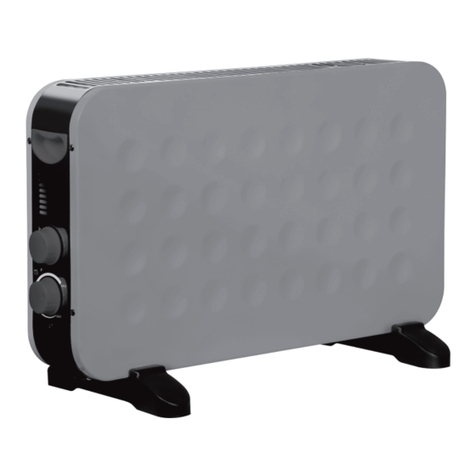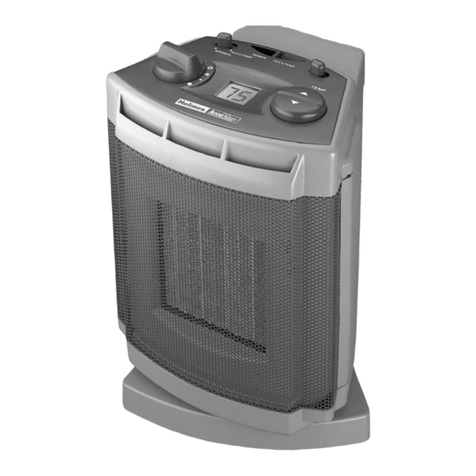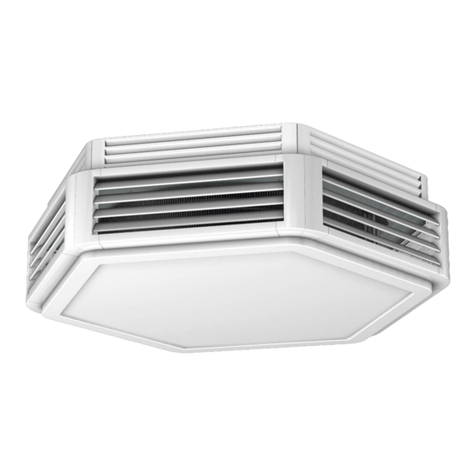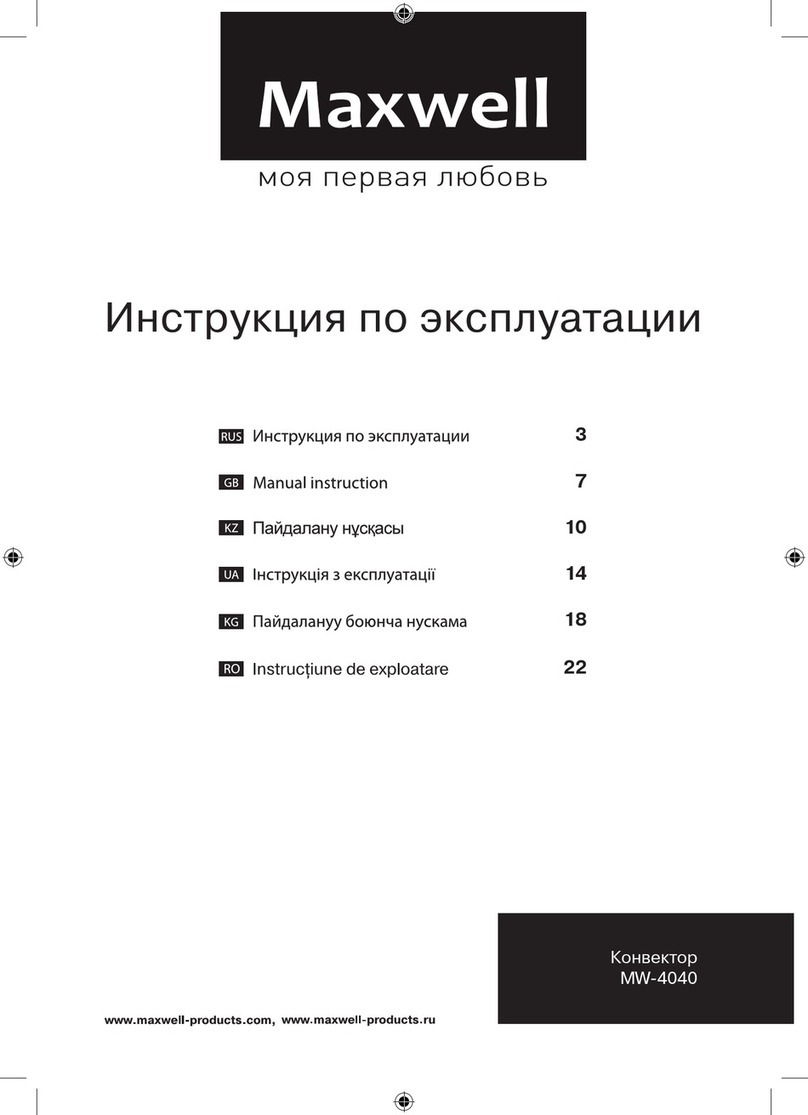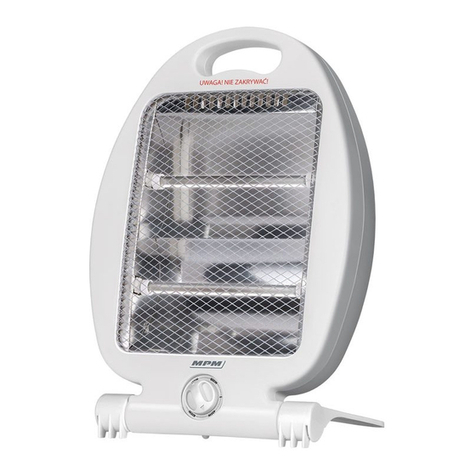Robur Supercromo User manual

Installation, use and maintenance manual
Supercromo
Fired by natural gas/LPG
Independent gas-red convectors with direct exchange
to heat small and medium sized rooms

Revision: F
Code: D-LBR106
This Installation, use and maintenance manual has been drawn up and printed by Robur S.p.A.; whole or partial
reproduction of this Installation, use and maintenance manual is prohibited.
The original is led at Robur S.p.A.
Any use of this Installation, use and maintenance manual other than for personal consultation must be previously
authorised by Robur S.p.A.
The rights of those who have legitimately led the registered trademarks contained within this publication are not
aected.
With the aim of continuously improving the quality of its products, Robur S.p.A. reserves the right to modify the
data and contents of this Installation, use and maintenance manual without prior notice.
DISPOSAL
The appliance and all its accessories must be disposed of separately in accordance with the regulations in force.
Use of theWEEE symbol (Waste Electrical and Electronic Equipment) indicates that this product cannot be disposed of as house-
hold waste. Proper disposal of this product helps to prevent potential negative consequences for the environment and human
health.

Installation, use and maintenance manual – Supercromo 3
INDEX OF CONTENTS
I Introduction..........................................................................
p.4
I.1 Recipients................................................................
p.4
II Symbols and denitions.........................................
p.4
II.1 Key to symbols ......................................................
p.4
II.2 Terms and denitions .........................................
p.4
III Warnings...................................................................................
p.4
III.1 General and safety warnings............................
p.4
III.2 Compliance.............................................................
p.5
III.3 Exclusions of liability and warranty ...............
p.6
1 Features and technical data................................
p.7
1.1 Features....................................................................
p.7
1.2 Dimensions.............................................................
p.8
1.3 Electrical wiring diagram...................................
p.8
1.4 Controls....................................................................
p.9
1.5 Technical data........................................................
p.9
2 Transport and positioning....................................
p.9
2.1 Warnings..................................................................
p.9
2.2 Handling..................................................................
p.9
2.3 Appliance positioning ......................................
p.10
2.4 Minimum clearance distances.......................
p.10
3 Heating engineer...........................................................
p.10
3.1 Warnings................................................................
p.10
3.2 Supplied material...............................................
p.10
3.3 Fuel gas supply....................................................
p.10
3.4 Combustion products exhaust......................
p.12
3.5 Installation procedure ......................................
p.14
4 Electrical installer.........................................................
p.16
4.1 Warnings................................................................
p.16
4.2 Electrical power supply....................................
p.16
5 First start-up.......................................................................
p.17
5.1 Preliminary checks.............................................
p.17
5.2 Checking burner gas pressure.......................
p.17
5.3 Gas changeover ..................................................
p.18
6 Normal operation.........................................................
p.19
6.1 Warnings................................................................
p.19
6.2 Control panel .......................................................
p.20
6.3 Switch on and o................................................
p.20
6.4 Programmable timer.........................................
p.20
7 Maintenance.......................................................................
p.23
7.1 Warnings................................................................
p.23
7.2 Cleaning and maintenance.............................
p.23
7.3 Safety devices......................................................
p.23
7.4 Any malfunctions of operation .....................
p.23
8 Appendices...........................................................................
p.25
8.1 ErP data sheets....................................................
p.25

Introduction
4
I
I INTRODUCTION
Installation, use and maintenance manual
This Manual is an integral part of the Supercromo
appliance and must be handed to the end user to-
gether with the appliance.
I.1 RECIPIENTS
This Manual is intended for:
▶
End user, for appropriate and safe use of the appliance.
▶
Qualied installer, for correct appliance installation.
▶
Planner, for specic information on the appliance.
II SYMBOLS AND DEFINITIONS
II.1 KEY TO SYMBOLS
DANGER
WARNING
NOTE
PROCEDURE
REFERENCE (to other document)
II.2 TERMS AND DEFINITIONS
Appliance/Unit = equivalent terms, both used to refer to
the independent direct exchange gas-red convector.
TAC = Technical Assistance Centre authorised by Robur.
First start-up = appliance commissioning operation
which may only and exclusively be carried out by a TAC.
III WARNINGS
III.1 GENERAL AND SAFETY WARNINGS
Installer's qualications
Installation must exclusively be performed by a
qualied rm and by skilled personnel, with spe-
cic knowledge on heating, electrical systems and
gas appliances, in compliance with the laws in
force in the Country of installation.
Declaration of conformity
Upon completing installation, the installing rm
shall issue to the owner/client the appliance's
workmanlike conformity declaration, according to
national/local regulations in force and the manu-
facturer's instructions/provisions.
Misuse
The appliance must only be used for the purpos-
es for which it has been designed. Any other use is
deemed hazardous. Incorrect use may aect oper-
ation, duration and safety of the appliance. Adhere
to the manufacturer's instructions.
Use of the appliance by children
The appliance can be used by children over 8 years
old, and by people with reduced physical, senso-
ry or mental capabilities, or lack of experience or
knowledge, only if they are under surveillance or
after they have received instructions regarding
safe use of the appliance and understanding the
dangers inherent in it. Children should not play
with the appliance.
Hazardous situations
Do not start the appliance in hazardous conditions,
such as: gas smell, problems with the electrical/gas
system, parts of the appliance under water or dam-
aged, malfunctioning, disabling or bypassing con-
trol and safety devices.
In case of danger, request intervention by qualied
personnel.
In case of danger, switch o the electrical power
and gas supplies only if this can be done in total
safety.
Do not entrust children, persons with physical,
sensory or mental disabilities or persons with poor
knowledge and experience with use of the appli-
ance.
Gas component tightness
Before performing any operation on gas ducting
components, close the gas valve.
Upon completing any procedure, perform the
tightness test according to regulations in force.
Gas smell

Warnings
Installation, use and maintenance manual – Supercromo 5
III
If you smell gas:
Do not use electrical devices such as telephones,
multimeters or other equipment that may cause
sparks next to the appliance.
Shut o the gas supply by turning the valve o.
Open immediately doors and windows to create a
cross-current of air to ventilate the room.
Switch o the power supply via the external dis-
connect switch in the power supply electrical pan-
el.
Use a telephone away from the appliance to ask for
intervention from qualied personnel.
Poisoning
Ensure the ue gas ducts are tight and compliant
with the regulations in force.
Upon completing any procedure, ensure the tight-
ness of the components.
Moving parts
The appliance contains moving parts.
Do not remove guards during operation, and in
any case prior to disconnecting the power supply.
Burn hazard
The appliance contains very hot parts.
Do not open the appliance and do not touch inter-
nal components before the appliance has cooled
down.
Do not touch the ue gas exhaust before it has
cooled down.
Electrocution hazard
Disconnect the electrical power supply before any
operation on appliance components.
For electrical connections exclusively use compli-
ant components and according to the specica-
tions provided by the manufacturer.
Ensure the appliance cannot be accidentally
switched back on.
Earthing
Electrical safety depends on eective earthing sys-
tem, correctly connected to the appliance and in-
stalled according to the regulations in force.
Air ow
Do not obstruct the fan intake or the warm air
outlet.
Distance from combustible or ammable mate-
rials
Do not deposit ammable materials (paper, dilu-
ents, paints, etc.) near the appliance.
Comply with current regulations.
Aggressive substances in the air
The air of the installation site must be free from ag-
gressive substances.
Switching the appliance o
Disconnecting the power supply while the appli-
ance is running may cause permanent damage to
internal components.
Except in the event of danger, do not disconnect
the power supply to switch o the appliance, but
always and exclusively act through the provided
control device.
In the event of failure
Operations on internal components and repairs
may exclusively be carried out by a TAC, using only
original spare parts.
In the event of failure of the appliance and/or
breakage of any component, do not attempt to
repair and/or restore and immediately contact the
TAC.
Routine maintenance
Proper maintenance assures the eciency and
good operation of the appliance over time.
Maintenance must be performed according to the
manufacturer's instructions (see Chapter 7
p. 23
)
and in compliance with current regulations.
Appliance maintenance and repairs may only be
entrusted to rms legally authorised to work on
gas appliances and systems.
Enter into a maintenance contract with an author-
ised specialised rm for routine maintenance and
for servicing in case of need.
Use only original parts.
Keep the Manual
This Installation, use and maintenance manual
must always accompany the appliance and must
be handed to the new owner or installer in the
event of sale or removal.
III.2 COMPLIANCE
EU directives and standards
The Supercromo series gas-red convectors are certied
in accordance with European regulation GAR 426/2016/
EU and meet the essential requirements of the following
Directives:
▶
2016/426/EU "Gas Appliances Regulation" as amend-
ed and added.
▶
2014/30/EC "Electromagnetic Compatibility Directive"
as amended and added.
▶
2014/35/EC "Low Voltage Directive" as amended and
added.

Warnings
6
III
▶
2006/42/EC "Machine Directive" as amended and add-
ed.
▶
2015/1186/EU "Energy labelling of local space heaters
regulation" as amended and added.
▶
2015/1188/EU "Ecodesign requirements for local
space heaters regulation" as amended and added.
Furthermore, they comply with the requirements of the
following standards:
▶
EN 1266 Independent gas-red convection heaters in-
corporating a fan to assist transportation of combus-
tion air and/or ue gases
Other applicable provisions and standards
The design, installation, operation and maintenance of
the systems shall be carried out in compliance with cur-
rent applicable regulations, depending on the Country
and location, and in accordance with the manufacturer's
instructions. In particular, regulations regarding the fol-
lowing shall be complied with:
▶
Gas systems and equipment.
▶
Electrical systems and equipment.
▶
Heating systems.
▶
Environmental protection and combustion products
exhaust.
▶
Fire safety and prevention.
▶
Any other applicable law, standard and regulation.
III.3 EXCLUSIONS OF LIABILITY AND
WARRANTY
Any contractual or extra-contractual liability of the
manufacturer for any damage caused by incorrect
installation and/or improper use and/or failure to
comply with regulations and with the manufactur-
er's directions/instructions shall be disclaimed.
In particular, the warranty on the appliance may be
rendered void by the following conditions:
Incorrect installation.
Misuse.
Failure to comply with the manufacturer's indica-
tions on installation, use and maintenance.
Alteration or modication of the product or any
part thereof.
Extreme operational conditions or however out-
side of the operational ranges set forth by the man-
ufacturer.
Damages caused by external agents such as salts,
chlorine, sulphur or other chemical substances
present in the air of the installation site.
Abnormal actions transmitted to the appliance by
the system or installation (mechanical stresses,
pressure, vibrations, thermal expansion, electrical
surges...).
Accidental damages or due to force majeure.

Features and technical data
Installation, use and maintenance manual – Supercromo 7
1
1 FEATURES AND TECHNICAL DATA
1.1 FEATURES
1.1.1 Operation
The Supercromo gas-red convector is an independent
heating appliance with sealed combustion chamber and
forced draught.
It has been designed to be installed inside the room to be
heated.
It is suitable for operation with natural gas (G20) and LPG
(G30/G31) (gas-red convector belonging to category
II2H3+ according to EN 1266).
The combustion air intake and the exhaust of ue gases
take place outside via two coaxial pipes and are ensured
by the operation of a blower placed in the combustion cir-
cuit. Therefore, the gas-red convector must be installed
on an external perimetral wall or close to it, depending
on the maximum extension of the pipes (see Paragraph
3.4
p.12
).
The operation principle of the Supercromo gas-red con-
vector is based on a convective motion of room air that
passes through the gas-red convector from bottom to
top, is heated and diused into the room through the up-
per grille. The recirculation of the room air is facilitated by
the presence of a fan placed in the lower part of the gas-
red convector.
For this reason, do not place clothes, newspa-
pers or any other object that could obstruct the
air outlet directly on the grille. Also make sure
that curtains, backs of chairs or furniture are
not placed at a distance of less than 30 cm from
the gas-red convector.
The operation of the gas-red convector, very simple in
itself, is made completely automatic by the thermostatic
regulation and the programmable timer (standard in the
3002 model, optional in the 3001 model): the user is only
required to switch on the gas-red convector beforehand,
to choose the desired temperature (set on the regulation
thermostat) and, for the 3002 model, the operating period
(set on the programmable timer).
The sealed combustion chamber is the best guarantee of
safety for the environment in which the gas-red convec-
tor is installed: there is no possibility of the products of
combustion leak, nor is the oxygen necessary for combus-
tion taken from the environment. The appliance, once in-
stalled in accordance with the installation standards, does
not require any ventilation openings in the room.
A ame detection device using an ionisation probe in-
terrupts the gas supply in the event of an accidental
shutdown.
1.1.2 Mechanical components
▶
Sealed combustion chamber.
▶
High-eciency tubular steel heat exchanger.
▶
Centrifugal fan.
▶
Ø 49/35 mm coaxial combustion air intake and ue
gas exhaust pipes.
▶
External windproof terminal in aluminium alloy (pat-
ented).
▶
Casing in epoxy powder-coated sheet metal.
▶
Support bracket for wall mounting.
1.1.3 Control and safety devices
▶
Electronic management board providing the follow-
ing functions:
burner ignition
ame monitoring
blower management and control
fan control
heat exchanger temperature probe control
▶
Manual reset limit thermostat.
▶
Flue gas exhaust blower.
▶
Gas solenoid valve.
▶
Thermostat for setting the desired temperature.
▶
Programmable timer (standard on 3002 model, op-
tional on 3001 model).

Features and technical data
8
1
1.2 DIMENSIONS
Figure1.1Dimensions
≥100
≥ 130 < 350
173
30
35
49
100
478
100
577
151
239
239
1.3 ELECTRICAL WIRING DIAGRAM
Figure1.2Wiring diagram for models 3001 and 3002
EV Gas valve (Power supply: terminals 1 and 3 - Serial con-
nection of the coils: terminals 2 and 4)
F.A. Noise lter
L Line
M1 Limit thermostat
M2 Fan thermostat
M4 Control unit
M9 2 A fuse
N Neutral
P1 Reset button
RP7 Ignition electrode
RP8 Detection electrode
S Combustion air blower
SB Red lock-out signal light
SF Green operation signal light
V Fan
Z Manual/programmed switch (present on 3002 model
only)
Z8 Programmable timer (present on 3002 model only)
Z9 Room thermostat
GND Earth

Transport and positioning
Installation, use and maintenance manual – Supercromo 9
2
1.4 CONTROLS
1.4.1 Control device
The operation of the appliance is regulated by the control
panel supplied as standard, which includes a thermostat
for adjusting the temperature and a programmable timer
(standard on 3002 model, optional on 3001 model).
For further information please refer to Paragraph
6.2
p.20
.
1.5 TECHNICAL DATA
Table1.1Technical data
3001 3002
Heating mode
Heat input nominal (1013 mbar - 15 °C) (1) kW 2,6
Heat output nominal kW 2,3
Eciency nominal heat input % 90,0
Electrical specications
Power supply
voltage V 230
type - single-phase
frequency Hz 50
Electrical power absorption nominal kW 0,05
Installation data
Gas consumption
G20 natural gas (nominal) m³/h 0,27
G25 (nominal) m³/h 0,31
G30 (nominal) kg/h 0,15
G31 (nominal) kg/h 0,20
Gas connection type - M
thread “ 3/8
Flue gas exhaust
diameter (Ø) mm 50
type of installation - C13, C33, C63
residual head Pa 25
maximum equivalent length of coaxial exhaust duct m 1
sound power Lw(max) dB(A) 47,5
sound pressure Lpat 5 metres (max) dB(A) 28,5
Dimensions
width mm 478
height mm 577
depth mm 173
Weight in operation kg 17
(1) Relative to NCV (net caloric value).
2 TRANSPORT AND POSITIONING
2.1 WARNINGS
Damage from transport or installation
The manufacturer shall not be liable for any dam-
age during appliance transport and installation.
On-site inspection
Upon arrival at the site, ensure there is no transport
damage on packing.
After removing the packing materials, ensure the
appliance is intact and complete.
Packing
Only remove the packing after placing the appli-
ance on site.
Do not leave parts of the packing within the reach
of children (plastic, polystyrene, nails...) since they
are potentially dangerous.
Weight
The lifting equipment must be suitable for the load.
Lift up the unit and secure it to its support bracket
(Paragraph 3.5.1
p.14
).
2.2 HANDLING
2.2.1 Handling and lifting
▶
Always handle the appliance in its packing, as deliv-
ered by the factory.
▶
Comply with safety regulations at the installation site.

Heating engineer
10
3
2.3 APPLIANCE POSITIONING
The appliance must be installed in the room to be heated.
2.3.1 Where to install the appliance
▶
The gas-red convector must be installed on or near
an external perimeter wall, respecting the distances
indicated in Figure 1.1
p.8
.
▶
Avoid placement on walls or combustible materials
without a suitable heat shield.
▶
Do not install the gas-red convector over electrical
boxes/switches or distribution cabinets that require
periodic inspection.
Installation must not be made on walls with poor
strength that do not guarantee adequate resist-
ance to the stresses produced by the appliance.
The manufacturer assumes no responsibility if the
appliance is installed on surfaces or walls that are
not suitable to support its weight.
The appliance's ue gas exhaust must not be im-
mediately close to openings or air intakes of build-
ings, and must comply with safety and environ-
mental regulations.
Theuegasexhaustterminalisaccident-preventing
and requires no protection.
2.4 MINIMUM CLEARANCE DISTANCES
2.4.1 Distances from combustible or ammable
materials
▶
Keep the appliance away from combustible or am-
mable materials or components, in compliance with
applicable regulations.
2.4.2 Clearances around the appliance
The minimum clearance distances are required for
safety, operation and maintenance.
▶
The minimum recommended distance from the gas-
red convector to the oor is 13 cm (Figure 1.1
p. 8
)
and possibly not more than 35 cm, as higher heights
would result in uneven heat distribution in the heated
room.
▶
Keep a minimum clearance of 10 cm from the sides of
the gas-red convector to any obstacles to allow for
removal and retting of the casing.
▶
If a shelf is to be installed above the gas-red convec-
tor, leave a minimum clearance of 10 cm. No cover of
any type may be installed over the appliance.
3 HEATING ENGINEER
3.1 WARNINGS
3.1.1 General warnings
Read the warnings in Chapter III.1
p. 4
, pro-
viding important information on regulations and
on safety.
Compliance with installation standards
Installation must comply with applicable regula-
tions in force, based on the installation Country
and site, in matters of safety, design, implementa-
tion and maintenance of:
heating systems
gas systems
ue gas exhaust
Installation must also comply with the manufactur-
er's provisions.
3.2 SUPPLIED MATERIAL
▶
Installation jig in cardboard.
▶
Wall support bracket.
▶
Air duct Ø 49 mm, length 500 mm.
▶
Flue gas duct Ø 35 mm, length 500 mm.
▶
External ue gas terminal in aluminium alloy.
▶
Rear sealing strip.
▶
Round gasket for combustion air.
▶
3-pin plug for electrical connection.
▶
Screws and wall plugs.
▶
Documentation.
3.3 FUEL GAS SUPPLY
3.3.1 Gas connection
▶
3/8" M
on the right, at the bottom.
▶
The pipe required for connection is supplied with the
appliance. Connect it to the gas valve through hole C
(Figure 3.1
p.11
).
▶
Install an anti-vibration connection between the ap-
pliance and the gas piping.

Heating engineer
Installation, use and maintenance manual – Supercromo 11
3
Figure3.1Gas and power supply position
A Hole for power supply cable
B Terminal block
C Hole for gas pipe
D Cable gland bridge
A
B
C
D
The connection to the gas mains must be made
using a rigid copper or steel pipe and ttings; alter-
natively, a exible stainless steel pipe conforming
to the regulations in force may also be used.
The connection to the gas pipe must be properly
sealed to ensure tightness using a sealant that
complies with EN 751-1 and EN 751-2. The connec-
tion must be made in such a way that no strain is
produced in the pipe or gas-red convector com-
ponents.
3.3.2 Mandatory shut-o valve
▶
Provide a gas shut-o valve (manual) on the gas supply
line, next to the appliance, to isolate it when required.
▶
Provide a three-piece pipe union.
▶
Perform connection in compliance with applicable
regulations.
3.3.3 Gas pipes sizing
The gas pipes must not cause excessive pressure drops
and, consequently, insucient gas pressure for the
appliance.
3.3.4 Supply gas pressure
This appliance is equipped for a maximum gas
supply pressure of 50 mbar.
The appliance's gas supply pressure, both static and dy-
namic, must comply with Table 3.1
p.11
, with tolerance
± 15%.
Non compliant gas pressure (Table 3.1
p. 11
)
may damage the appliance and be hazardous.
Table3.1Network gas pressure
Gas supply pressure [mbar]
Product category Countries of destination G20 G25 G30 G31 G30 G31
II2H3B/P
AT, BG, CZ, DK, EE, FI, HR, LT, LV, MK, RO, SE, SI, SK,
TR 20 30 30
AT 20 50 50
II2H3P BG, EE, HR, LT, SI, SK 20 37
II2H3+ CZ, ES, GB, GR, IE, IT, PT, SK 20 28-30 37
II2Esi3+ FR 20 25 28-30 37
I3+ FR, BE 28-30 37
II2H3B/P HU 25 30 30
II2E3B/P
LU 20 50
PL 20 37 37
DE 20 50 50
I2H LV 20
The appliance gas supply pressure, both static and dynamic, must comply with the values in theTable, with a tolerance of ± 15%.

Heating engineer
12
3
I3P NO 30
I3B/P MT, CY 30 30
I3B 30
The appliance gas supply pressure, both static and dynamic, must comply with the values in theTable, with a tolerance of ± 15%.
3.3.5 Vertical pipes and condensate
▶
Vertical gas pipes must be tted with siphon and dis-
charge of the condensate that may form inside the
pipe.
▶
If needed, insulate the piping.
3.3.6 LPG pressure reducers
With LPG the following must be installed:
▶
A rst stage pressure reducer, close to the liquid gas
tank.
▶
A second stage pressure reducer, close to the appli-
ance.
Pressure reducers must always be installed outside
the building.
3.4 COMBUSTION PRODUCTS EXHAUST
Compliance with standards
The appliance is approved for connection to a
combustion products exhaust duct for the types
shown in Table 1.1
p.9
.
3.4.1 Flue gas exhaust and combustion air
intake connection
▶
Ø 50 mm on the rear (Figure 1.1
p.8
)
3.4.2 Installation types
The ue gas exhaust/combustion air intake of the
Supercromo gas-red convectors can be realised in one of
the following ways:
▶
With coaxial pipes with outlet on the installation
wall (maximum pipe length: 1 metre) (see Figure
3.2
p.12
).
▶
With coaxial pipes with 90° outlet (max pipe length: 1
metre) (see Figure 3.3
p.13
). In this case, it is neces-
sary to use the 90° casing for coaxial pipes, available as
OCFF004 optional.
▶
With separate pipes (see Figure 3.4
p. 13
). In this
case, it is necessary to use the separate exhaust casing
available as OCFF002 optional.
Warnings
The installation of pipes with a vertical downward
outlet is prohibited (leads to recirculation of ue
gas with lock-out of the appliance).
It is forbidden to install coaxial pipes with a vertical
outlet upwards (due to rain, water, objects inltra-
tion with consequent lock out of the appliance).
Figure3.2Installation with straight coaxial pipes
A Air pipe Ø 49 mm
B Flue gas pipe Ø 35 mm
C Adhesive gasket
D Support bracket
E Wall terminal Ø 35 mm
A
B
C
D
E
IM14044

Heating engineer
Installation, use and maintenance manual – Supercromo 13
3
Figure3.3Installation with coaxial pipes with 90° outlet
A Air pipe Ø 49 mm
B Flue gas pipe Ø 35 mm
C Adhesive gasket
D Support bracket
E Wall terminal Ø 35 mm
F 90° casing for coaxial exhaust
A
B
C
D
E
F
IM14045
Figure3.4Installation with wall separate ducts
A Air/ue gas pipe Ø 35 mm
B Elbow 90° M/F Ø 35 mm
C Adhesive gasket
D Support bracket
E Wall terminal Ø 35 mm
F 90° casing for separate exhaust
G Condensate discharge Ø 35 mm
D
A
BAA
AA
A
B
B
B
E
F
C
G
For further information on the installation of the
ue gas exhaust/air intake duct, please refer to the
installation guide for the ue gas exhaust/air intake
ducts D-GPP001, available on the Robur website.
3.4.2.1 Installation with separate ducts
If the appliance is installed with separate pipes, suitable
pipes and components, available as optional, must be
used.
At the design stage, it must be veried that the sum of the
pressure drop of all components used does not exceed
the value of the available residual head (Table 3.2
p.13
).
Table3.2Separate exhaust pressure drop table
Description Code 3001 3002
residual head Pa 25 25
Air pipe internal Ø 33 mm OPRL000 Pa/m 0,6 0,6
Horizontal ue gas pipe internal Ø 33 mm OPRL000 Pa/m 1,5 1,5
Vertical ue gas pipe internal Ø 33 mm OPRL000 Pa/m 0,2 0,2
90° elbow on air pipe OCRV000 Pa 0,6 0,6
90° elbow on ue gas pipe OCRV000 Pa 1,0 1,0
Casing complete with internal elbow for ue gas exhaust OCFF002 Pa 1,5 1,5
Casing without internal elbow for ue gas exhaust OCFF002 Pa 1,0 1,0
Roof terminal Ø 35 mm OTRM002 Pa 0,0 0,0
Wall terminal JTRM000B Pa 0,0 0,0
Condensate discharge Ø 35 mm OSCR003 Pa 0,0 0,0
If the ue gas pipe is longer than 1,5 metres, a condensate drain (available as OSCR003 optional) must be installed

Heating engineer
14
3
on the pipe as close as possible to the appliance. To limit
the formation of condensate, it is in any case advisable to
insulate the ue gas pipe with a material resistant to high
temperatures.
Due to the high temperatures that the ue gas pipe
can reach, it is still advisable to insulate it from the
wall and from potential contact with things and
people, for example by using rock wool or glass
wool.
The ue gas exhaust terminal, if used only for ue
gas exhaust, must also be protected against acci-
dental contact with people and things, due to the
high temperatures it can reach.
3.5 INSTALLATION PROCEDURE
In accordance with the installation project, prepare the
gas and electrical supply lines, as well as the holes for the
ue gas outlet and combustion air intake.
3.5.1 Install the gas-red convector on the wall
1. Check the packaging for visible signs of damage, oth-
erwise, notify the carrier immediately.
2. Remove the gas-red convector from its packaging
by rst removing the air intake and ue gas exhaust
pipes. Do not damage or discard the cardboard jig
with the drilling template required for installing the
gas-red convector.
3. Fix the jig to the wall where the gas-red convector is
to be installed, making sure it is perpendicular to the
oor.
4. Drill the hole (Ø 50 mm) to house the larger pipe and
holes A (Figure 3.6
p. 15
) to x the support brack-
et (drill 6 mm holes to insert the provided wall plugs).
The Ø 50 mm hole for the duct can be made with a
suitable core drill or by means of a succession of small-
er holes made with a simple drill on the perimeter to
be removed.
5. Adjust the length of the pipes (air intake and ue gas
exhaust) to the actual thickness of the wall by cutting
o the excess length: to determine the exact length
see diagram Figure 3.5
p.14
.
The coaxial duct must in any case not be less than
20 cm in length (ue gas pipe 200 + 33 mm, air in-
take pipe 200 + 2 mm).
In the Ø 49 pipe, do not cut the side with the
edging, which will later be used to secure the pipe.
In the Ø 35 pipe, do not cut o the side with a skirt-
ed end that will be used to t the pipe to the gas-
red convector.
6. Remove the jig from the wall.
Figure3.5Indications for cutting air/ue gas pipes

Heating engineer
Installation, use and maintenance manual – Supercromo 15
3
Figure3.6Support bracket positioning and holes drilling
A Bracket xing holes
B Support bracket
C Adhesive gasket
D Air pipe
B
D
C
A
7. Position the support bracket and the air intake pipe Ø
49, making sure that the pipe edge perfectly enters the
matching hole in the bracket (see Figure 3.6
p.15
).
8. Fix the support bracket with the screws and position
the round adhesive gasket around the hole in the
bracket (see Figure 3.6
p.15
).
9. Remove the casing from the frame complete with
heating body by loosening the xing screws (see
Figure 3.7
p. 15
) and disconnect the casing earth
cable.
10.Fit the end of the ue gas exhaust pipe (Ø 35 mm)
onto the gas-red convector outlet socket (Figure
3.8
p.15
).
11.Hook the appliance to the appropriate brackets A
(Figure 3.9
p. 16
) by pressing it against the wall.
Secure the heating body to the support brack-
et by means of the two side screws (detail B Figure
3.9
p.16
).
12.Connect the power supply as described in Paragraph
4.2
p.16
.
13.Connect the gas network as described in Paragraph
3.3
p.10
.
14.Connect the grounding cable of the casing and reas-
semble the casing.
Figure3.7Casing xing screws
Figure3.8Positioning the ue gas exhaust pipe
1 Flue gas pipe Ø 35 mm
1

Electrical installer
16
4
Figure3.9Support bracket detail
A Supports B Fastening screws
A
B
3.5.2 Install the windproof terminal
1. When the appliance is installed, place the alumini-
um windproof terminal to the outdoor wall so that it
engages with the end of the ue gas pipe and mark
the position of the three holes for the expansion plugs
(see Figure 3.10
p. 16
). The terminal must be tted
with the ue outlet grille arranged vertically.
2. Remove the terminal and drill the xing holes (6 mm Ø
for the supplied wall plugs).
3. Reassemble the terminal and secure it with the screws
using the relevant plugs (see Figure 3.10
p.16
).
Figure3.10Windproof terminal xing
4 ELECTRICAL INSTALLER
4.1 WARNINGS
General warnings
Read the warnings in Chapter III
p. 4
, provid-
ing important information on regulations and on
safety.
Compliance with installation standards
Installation must comply with applicable regula-
tions in force, based on the installation Country
and site, in matters of safety, design, implementa-
tion and maintenance of electrical systems.
Installation must also comply with the manufactur-
er's provisions.
Live components
After placing the appliance in the nal position,
and prior to making electrical connections, ensure
not to work on live components.
Earthing
The appliance must be connected to an eective
earthing system, installed in compliance with reg-
ulations in force.
It is forbidden to use gas pipes as earthing.
Cable segregation
Keep power cables physically separate from signal
ones.
Do not use the power supply switch to turn the
appliance on/o
Never use the power supply switch to turn the ap-
pliance on and o, since it may be damaged in the
long run (occasional blackouts are tolerated).
To turn the appliance on and o, exclusively use
the suitably provided control device.
4.2 ELECTRICAL POWER SUPPLY
Provide (by the installer) a protected single-phase line
(230 V 1-N 50 Hz).
How to connect the power supply
1. Provide a three-core H05 VVF 3x1 mm² cable with a
maximum external diameter of 8,4 mm by passing it
through hole A and cable gland D and connecting it
to terminal block B (Figure 3.1
p.11
), taking care to
observe the polarity indicated on the terminal block (L
= phase, N = neutral, = earth).
2. Provide the earth lead-in wire longer than live ones
(last to be torn in the event of accidental pulling).
3. The cable shall be tted with a plug at one end or con-
nected to a two-pole switch with a minimum contact
opening of 3 mm.
4. If an external three-pin plug is used, it is advisable to
placeamarkontheplugandonthepowersupplysock-
et, in order to avoid that in case of temporary removal
of the plug, it is reinserted in reverse, with consequent

First start-up
Installation, use and maintenance manual – Supercromo 17
5
reversal of the polarity of the power supply.
5 FIRST START-UP
First start-up entails checking/setting up the com-
bustion parameters and may exclusively be carried
out by a Robur TAC. NEITHER the user NOR the in-
stallation technician is authorised to perform such
operations, under penalty of voiding the warranty.
The installer is obliged to carry out preliminary
checks described in Paragraph 5.1
p.17
.
5.1 PRELIMINARY CHECKS
Paragraph dedicated to the installer.
5.1.1 Preliminary checks for rst start-up
Upon completing installation, before contacting the TAC
the installer must check:
▶
Electrical and gas systems suitable for the required ca-
pacities and equipped with all safety and control de-
vices required by the regulations in force.
▶
Absence of leaks in the gas system.
▶
Type of gas for which the appliance is designed (natu-
ral gas, LPG or other gas).
▶
Supply gas pressure complying with the values of
Table 3.1
p.11
, with max tolerance ±15%.
▶
Correct operation of the ue exhaust duct.
▶
Combustion air intake and ue gas exhaust correctly
carried out according to the regulations in force.
▶
Power supply mains complying with the appliance's
rating plate data.
▶
Appliance correctly installed, according to the manu-
facturer's provisions.
▶
System installed in a workmanlike manner, according
to national and local regulations.
5.1.2 Abnormal or hazardous installation
situations
Should any abnormal or hazardous installation situations
be found, the TAC shall not perform rst start-up and the
appliance shall not be commissioned.
These situations may be:
▶
Failed compliance with minimum clearances.
▶
Insucient distance from combustible materials.
▶
Conditions that do not warrant access and mainte-
nance in safety.
▶
Appliance defects or faults caused during transport or
installation.
▶
Gas smell.
▶
Non-compliant mains gas pressure.
▶
Non-compliant ue gas exhaust.
▶
All situations that may involve operation abnormali-
ties or are potentially hazardous.
5.1.3 Non-compliant system and corrective
actions
Should theTAC nd any non conformities, the user/install-
er is bound to perform any corrective procedures required
by the TAC.
After performing the remedial actions (the installer's re-
sponsibility), if the TAC deems that safety and conformity
conditions are in place, rst start-up may be eected.
5.2 CHECKING BURNER GAS PRESSURE
Paragraph reserved exclusively toTACs.
The gas supply circuit is equipped with a gas so-
lenoid valve with double safety shutter and pres-
sure regulator to control the gas ow. All models
are factory-set to operate with natural gas and can
be converted to LPG (see Paragraph 5.3
p. 18
).
Each gas-red convector is calibrated during fac-
tory testing for operation with natural gas. After
installation, check that the gas pressure at the
burner complies with indications in Paragraph
5.3.1
p.18
.
All adjustments must be made with the appliance
switched on and after removing the casing.
After completion of the gas pressure check at
the burner, the valve adjustment screws must be
sealed.
5.2.1 Natural gas supply
Figure 5.1
p.18
1. Remove the casing from the frame and disconnect the
casing grounding cable.
2. Connect a pressure gauge to the pressure intake A, af-
ter removing its sealing screw.
3. Switch on the appliance (Paragraph 6.3.1
p.20
).
4. Turn the thermostat to the highest heat demand.
5. Adjust the gas pressure at the burner to the required
value (Table 5.1
p. 18
) by means of the pressure
regulator B. By turning clockwise the pressure increas-
es, counterclockwise it decreases. Use a hex key for
adjustment.
6. When the adjustment is complete, switch o the
appliance.
After the adjustment, stop and start the appliance
and check that burner pressure has stabilised. If

First start-up
18
5
necessary perform the adjustment again.
7. Disconnect the pressure gauge and ret the sealing
screw.
8. Connect the grounding cable of the casing and reas-
semble the casing.
Figure5.1Valve assembly
A Pressure intake
B Pressure regulator
A
B
Table5.1Burner gas pressure
3001 3002
Installation data
Burner gas
pressure Nominal
heat input
G20 mbar 10,0
G25 mbar 9,0
G30 mbar 28,8
G31 mbar 36,7
5.2.2 LPG supply
For LPG supply, the gas-red convector must be converted
from natural gas to LPG by using the supplied gas change
kit and following the instructions in Paragraph 5.3
p.18
.
When operating with LPG gas, the maximum operating
pressure depends only on the network pressure, which
must be as indicated in Table 3.1
p.11
.
The reduction of the pressure in the network is
possible following the instructions in Paragraph
3.3.6
p.12
.
To adjust the gas-red convector for operation with LPG,
proceed as described below.
Figure 5.1
p.18
1. Remove the casing from the frame and disconnect the
casing grounding cable.
2. Connect a pressure gauge to the pressure intake A, af-
ter removing its sealing screw.
3. Switch on the appliance (Paragraph 6.3.1
p.20
).
4. Turn the thermostat to the highest heat demand.
5. Adjust the gas pressure at the burner to the required
value (Table 5.1
p.18
) by excluding pressure regula-
tor B (by fully tightening its screw) and adjusting the
second stage regulator if necessary.
6. When the adjustment is complete, switch o the
appliance.
After the adjustment, stop and start the appliance
and check that burner pressure has stabilised. If
necessary perform the adjustment again.
7. Disconnect the pressure gauge and ret the sealing
screw.
8. Connect the grounding cable of the casing and reas-
semble the casing.
5.3 GAS CHANGEOVER
Paragraph reserved exclusively toTACs.
After the gas changeover, check the combustion
parameters as described in Paragraph 5.2
p.17
.
Check that the gas supply line is suitable for the
new fuel type used to supply the unit.
5.3.1 Conversion from natural gas to LPG
Figure 5.2
p.19
1. Cut o electric power and gas supply.
2. Remove the casing from the frame and disconnect the
casing grounding cable.
3. Unscrew the B plug with a no. 19 wrench.
4. Using a no.10 socket wrench introduced in the open-
ing, unscrew the nozzle holder A.
5. Unscrew the calibrated nozzle C from the nozzle hold-
er A and replace it (Table 5.2
p.18
).
6. Screw the nozzle support and nozzle assembly back
on to the burner.
7. Reassemble the plug B.
8. Turn on the gas-red convector and check the gas
tightness of plug B.
9. Check the gas pressure at the burner as described in
Paragraph 5.2.2
p.18
.
10.Remove the "NATURAL GAS" adhesive label and re-
place it with the "LPG" adhesive label.
11.Connect the grounding cable of the casing and reas-
semble the casing.
Table5.2Gaz nozzles
3001 3002
Installation data

Normal operation
Installation, use and maintenance manual – Supercromo 19
6
3001 3002
Nozzle
Diame-
ter (Ø)
G20 mm 1,45/1,70
G25 mm 1.75/1,80
G30 mm 0.85/0,95
G31 mm 0.85/0,95
Code
G20 - 53
G25 - 54
G30 - 50
G31 - 50
Figure5.2Detail of burner assembly
A Nozzle holder. B Cap
A
B
A
C
5.3.2 Conversion from LPG to natural gas
Figure 5.2
p.19
1. Cut o electric power and gas supply.
2. Remove the casing from the frame and disconnect the
casing grounding cable.
3. Unscrew the B plug with a no. 19 wrench.
4. Using a no.10 socket wrench introduced in the open-
ing, unscrew the nozzle holder A.
5. Unscrew the calibrated nozzle C from the nozzle hold-
er A and replace it (Table 5.2
p.18
).
6. Screw the nozzle support and nozzle assembly back
on to the burner.
7. Reassemble the plug B.
8. Turn on the gas-red convector and check the gas
tightness of plug B.
9. Check the gas pressure at the burner as described in
Paragraph 5.2.1
p.17
.
10.Remove the "LPG" adhesive label and replace it with
the "NATURAL GAS" adhesive label.
11.Connect the grounding cable of the casing and reas-
semble the casing.
6 NORMAL OPERATION
This section is for the end user.
The operation of the Supercromo gas-red heaters is con-
trolled by the supplied control panel.
6.1 WARNINGS
General warnings
Prior to using the appliance carefully read the warn-
ings in Chapter III.1
p. 4
, providing important
information on regulations and on safety.
First startup by TAC
First start-up may exclusively be carried out by a
Robur TAC (Chapter 7
p.23
).
Never power the appliance o while it is run-
ning
NEVER power the appliance o while it is running
(except in the event of danger, Chapter III.1
p. 4
),
since the appliance or system might be damaged.

Normal operation
20
6
Do not obstruct the fan intake or the outlet
grille.
Do not obstruct the air intake and ue gas ex-
haust ducts located outside the room.
6.2 CONTROL PANEL
Figure6.1Control panel
A Reset button
B Temperature adjustment knob
C Red lock-out signal light
D Green operation signal light
E Manual/programmed button
F Programmable timer (standard on 3002 model, optional on
3001 model)
B
C D
A
E
F
AUTO
1
2
3
4
5
6
MAN RESET
6.3 SWITCH ON AND OFF
6.3.1 Switching on
1. Open the gas valve.
2. Power up the gas-red convector.
3. In the presence of the programmable timer (standard
on 3002 model, optional on 3001 model), program the
timer according to your needs (Paragraph 6.4
p.20
).
Set the manual/programmed button E (Figure
6.1
p. 20
) to the desired function (button released
or MAN position if you want the appliance to be con-
trolled only by the room thermostat or button pressed
or AUTO position if you want it to be controlled also by
the programmable timer).
For the 3002 model, make sure the programmable
timer operation is set to AUTO if you want to acti-
vate the time schedule.
4. Turn temperature control knob B to the highest tem-
perature setting.
5. After about 30 seconds the gas solenoid valve opens
and the ignition electrode begins to spark, for a maxi-
mum of 10 seconds.
6. If the ame is present, the detection electrode
automatically interrupts the sparking and keeps the
appliance running; the green operation signal light D
lights up.
7. If this is not the case, the control unit locks out the
appliance and the blower stops, lighting up red signal
light C. The reset must be carried out manually using
reset button A.
8. Once the appliance is switched on, turn knob B on the
thermostat clockwise to increase the room tempera-
ture and counterclockwise to decrease it.
9. The fan starts automatically only when it receives
the consent of the ventilation control thermostat, i.e.
when the heat exchanger is hot, in order to prevent
cold air from being introduced into the room and will
switch o when the heat exchanger is cold.
The gradation of the thermostat is purely indicative. The
value of the set temperature depends on the type of room
in which the appliance is installed. A relationship between
the position of the thermostat and the actual room tem-
perature can be obtained by measuring the room temper-
ature at a given thermostat setting.
6.3.2 Switching o
1. To temporarily switch o the appliance (e.g. during
the night period) turn knob B of the thermostat to
the minimum temperature position. This will ensure
a minimum temperature (antifreeze) for the room. For
models with a programmable timer (standard on 3002
model, optional on 3001 model) the appliance can be
temporarily switched o by setting the programmable
timer operation to OFF (Paragraph 6.4
p.20
).
2. For the season stop it is advisable to disconnect the
appliance from the power supply and close the gas
tap.
In models with a programmable timer (standard on
3002 model, optional on 3001 model), cutting the
power supply loses the day and time setting, which
must be reset the next time the power is turned on.
6.4 PROGRAMMABLE TIMER
6.4.1 Features
▶
Minimum switching time 1 minute.
▶
15 combinations of daily programs.
▶
16 ON/OFF programs for each daily program.
Table of contents
Other Robur Heater manuals
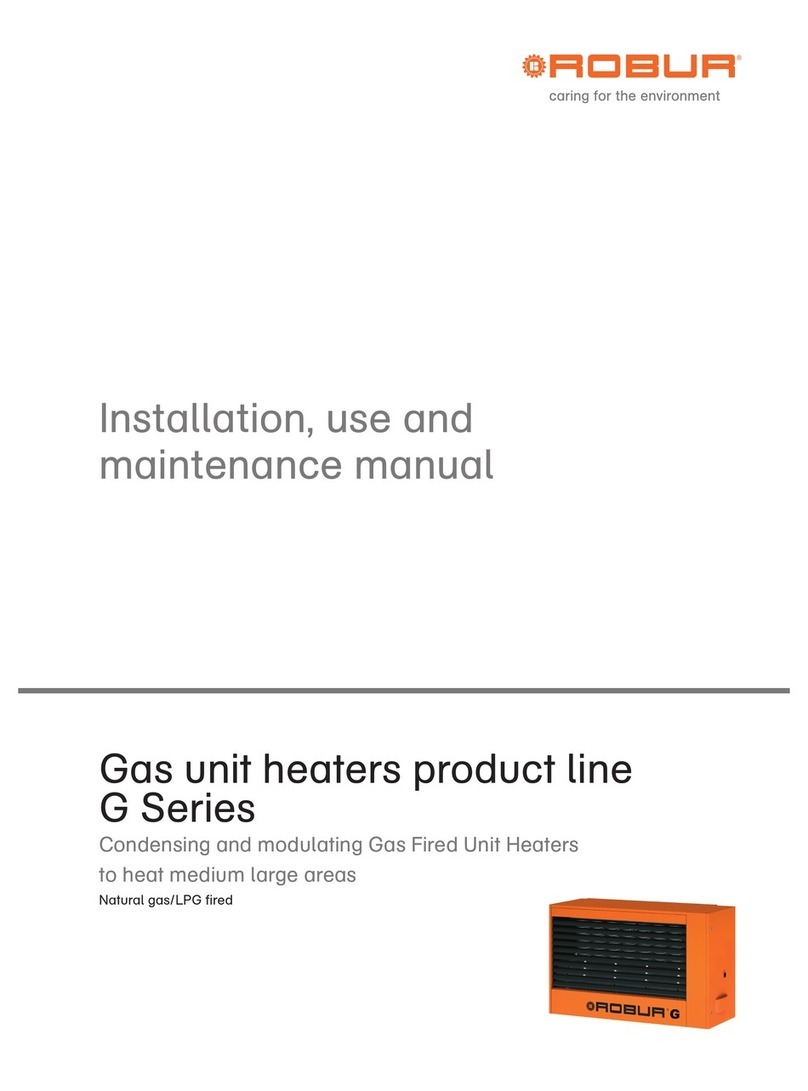
Robur
Robur G 30 Service manual
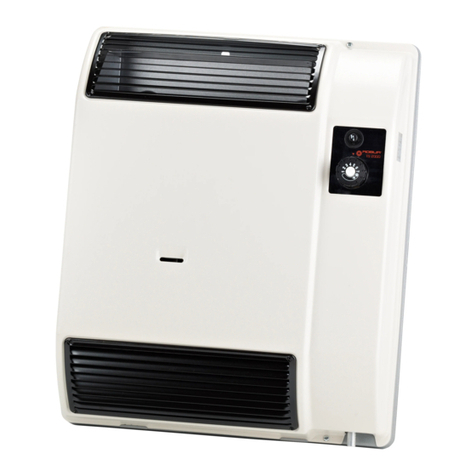
Robur
Robur TS 2000 User manual

Robur
Robur Supercromo D-LBR167 Quick start guide

Robur
Robur Next-R User manual

Robur
Robur 5001 User manual
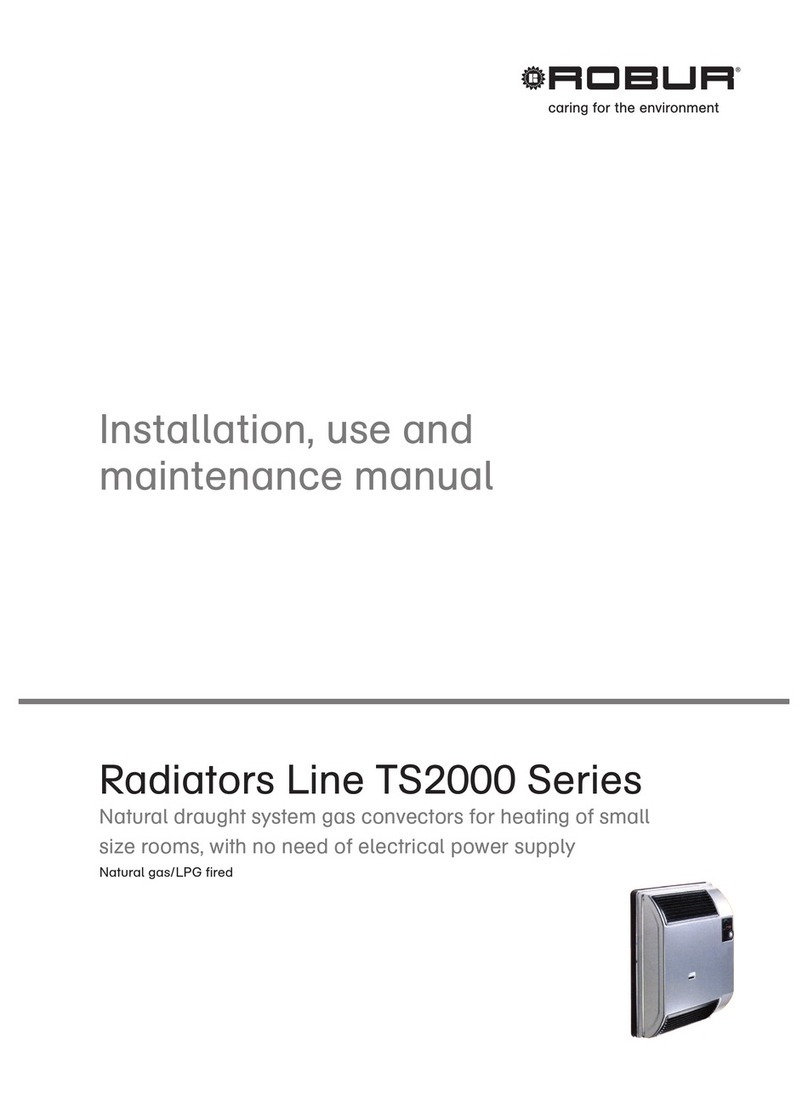
Robur
Robur TS2000 Series User manual
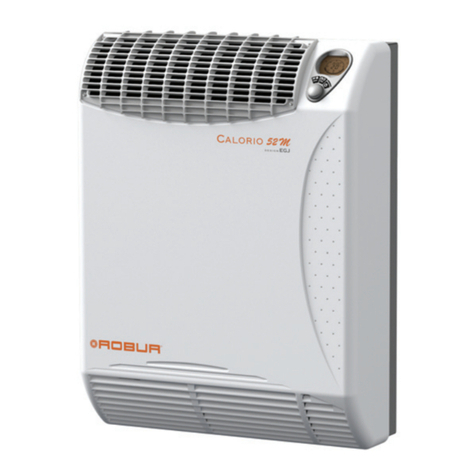
Robur
Robur Calorio M User manual
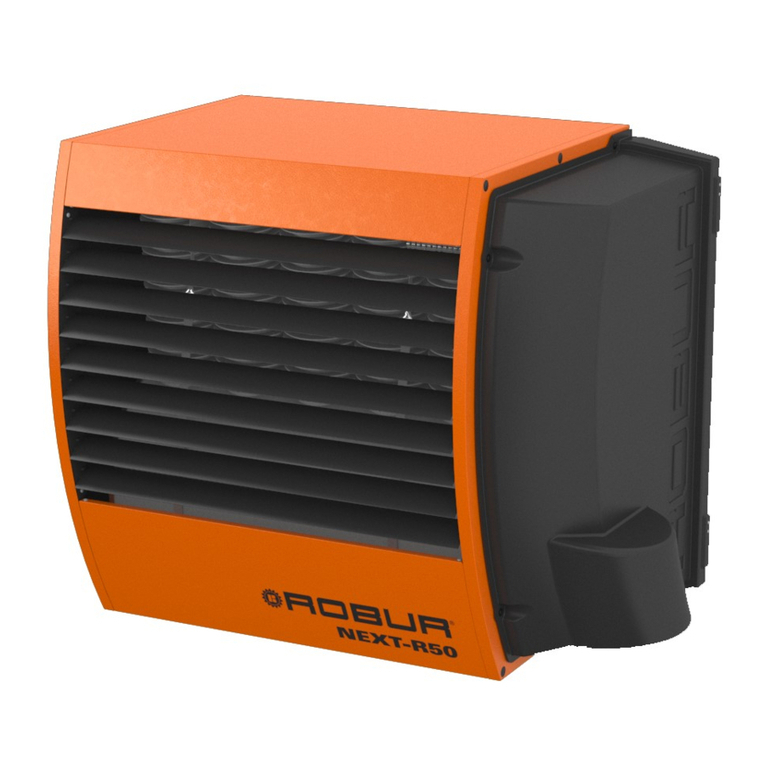
Robur
Robur Next-R Service manual

Robur
Robur Heaters Line F2 C Series Service manual
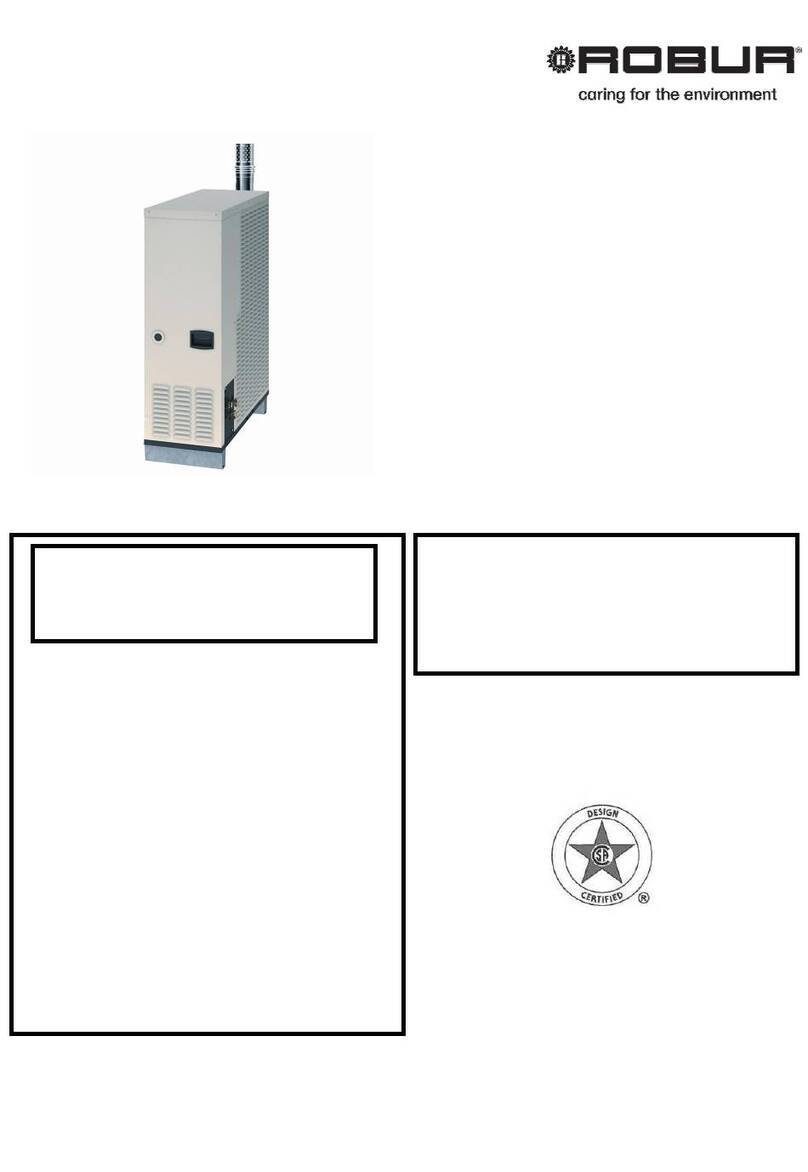
Robur
Robur AY00-119 Series User manual

